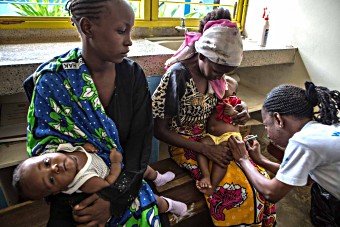
Pneumococcal vaccination in Kenya.
Credit: GAVI/2013/Evelyn Hockstein
Geneva, 7 July 2014 - In a study recently published in Lancet Global Health, researchers from Kenya found that widespread use of 10-valent pneumococcal conjugate vaccine (PCV10) reduces carriage of the pneumococcal bacterium in both vaccinated and unvaccinated individuals and is therefore expected to provide herd protection against pneumococcal disease.
Serious pneumococcal disease, which can manifest as pneumonia, meningitis or sepsis, is the leading cause of vaccine-preventable death among children under the age of five worldwide. Pneumococcal conjugate vaccine (PCV) use has been shown to dramatically reduce invasive pneumococcal disease caused by serotypes (strains) contained in the vaccine. With support from the GAVI Alliance, Kenya was among the first African countries to introduce PCV in 2011, and the first low-income country to use the 10-valent vaccine, which contains antigens that protect against the ten most commons strains.
PCV reduces invasive pneumococcal disease, both by directly protecting individuals from the bacteria and through indirect herd protection. A large proportion of the population asymptomatically “carries” bacteria in the back of the nose. Widespread use of PCV reduces carriage of vaccine-serotype bacteria in vaccinated individuals, thereby reducing transmission of these bacteria to those unvaccinated resulting in the protection of unvaccinated people from disease as well. This phenomenon is known as herd protection.
Researchers at the Kenya Medical Research Institute (KEMRI) conducted the study in Kilifi, Kenya, where infants received the national three-dose primary series of PCV10 and those aged between one and five years old received up to two doses as part of a catch-up campaign. Using data collected two years before and two years after the introduction of PCV10, researchers compared the carriage of vaccine-serotype and non-vaccine-serotype pneumococci in children under five years (the vaccinated age group) and unvaccinated persons five years and older.
The study found that introduction of PCV10 reduced carriage of vaccine-serotype pneumococci in two-thirds of the population, which includes both vaccinated and unvaccinated people. These findings were statistically significant and support the expected impact of PCV10 on invasive pneumococcal disease among both the vaccinated and unvaccinated age groups. PCV10 only protects against the serotypes contained in the vaccine, and therefore does not reduce carriage of non-vaccine serotypes. The ten serotypes against which PCV10 protects are estimated to account for at least 70% of pneumococcal disease in every region of the world, so introduction of the vaccine has the potential to greatly reduce pneumococcal disease.
The research was conducted by KEMRI, Johns Hopkins Bloomberg School of Public Health, University of Oxford, Kenya Ministry of Health and the London School of Hygiene & Tropical Medicine. It was funded by the GAVI Alliance and the Wellcome Trust.
